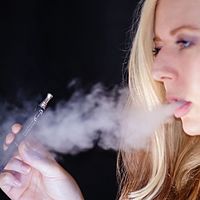
Photo from wikipedia
As of February 18, 2020, the e-cigarette, or vaping, product use associated lung injury (EVALI) outbreak caused the hospitalization of a total of 2,807 patients and claimed 68 lives in… Click to show full abstract
As of February 18, 2020, the e-cigarette, or vaping, product use associated lung injury (EVALI) outbreak caused the hospitalization of a total of 2,807 patients and claimed 68 lives in the United States. Though investigations have reported a strong association with vitamin E acetate (VEA), evidence from reported EVALI cases is not sufficient to rule out the contribution of other chemicals of concern, including chemicals in either THC or non-THC products. This study characterized chemicals evolved when diluent oils were heated to temperatures that mimic e-cigarette, or vaping, products (EVPs) to investigate production of potentially toxic chemicals that might have caused lung injury. VEA, vitamin E, coconut, and medium chain triglyceride (MCT) oil were each diluted with ethanol and then tested for constituents and impurities using a gas chromatograph mass spectrometer (GC/MS). Undiluted oils were heated at 25°C (control), 150°C, and 250°C in an inert chamber to mimic a range of temperatures indicative of aerosolization from EVPs. Volatilized chemicals were collected using thermal desorption tubes, analyzed using a GC/MS, and identified. Presence of identified chemicals was confirmed using retention time and ion spectra matching with analytic standards. Direct analysis of oils, as received, revealed that VEA and vitamin E were the main constituents of their oils, and coconut and MCT oils were nearly identical having two main constituents: glycerol tricaprylate and 2-(decanoyloxy) propane-1,3-diyl dioctanoate. More chemicals were measured and with greater intensities when diluent oils were heated at 250°C compared to 150°C and 25°C. Vitamin E and coconut/MCT oils produced different chemical emissions. The presence of some identified chemicals is of potential health consequence because many are known respiratory irritants and acute respiratory toxins. Exposure to a mixture of hazardous chemicals may be relevant to the development or exacerbation of EVALI, especially when in concert with physical damage caused by lung deposition of aerosols produced by aerosolizing diluent oils.
Journal Title: Frontiers in Public Health
Year Published: 2021
Link to full text (if available)
Share on Social Media: Sign Up to like & get
recommendations!